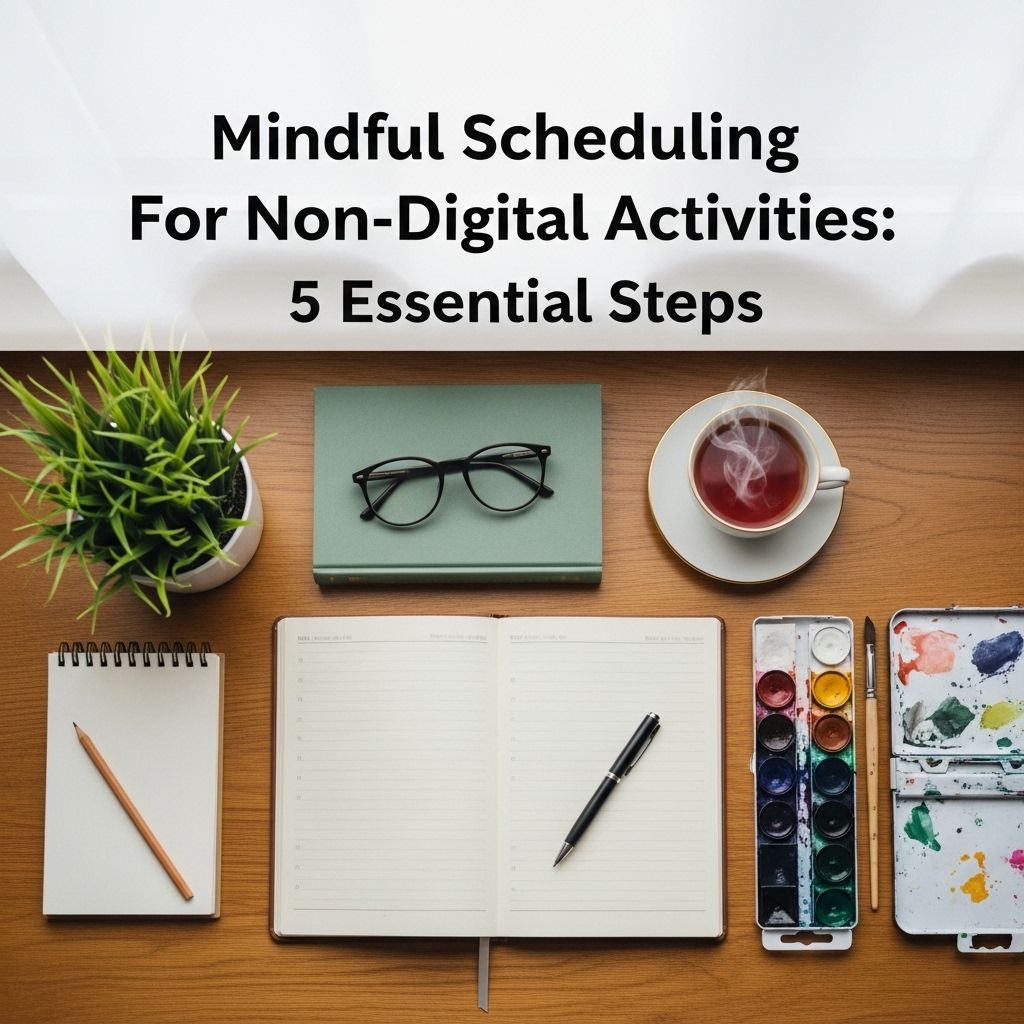Mindful Scheduling of Non-Digital Activities
Carving out screen-free intervals transforms routines with calm, clarity, and creative spark.

Introduction to Mindful Scheduling
Mindful scheduling involves planning and organizing tasks in a way that maximizes focus and efficiency while minimizing stress. This approach is particularly beneficial when applied to non-digital activities, which are often overlooked in today’s digitally driven world. By incorporating mindfulness into your daily routine, you can enhance productivity, reduce anxiety, and improve overall well-being.
Benefits of Mindful Scheduling
Mindful scheduling offers several advantages, especially when applied to non-digital activities:
- Increased Productivity: By focusing on non-digital tasks, you eliminate digital distractions, allowing you to complete tasks more efficiently.
- Reduced Stress: Mindful planning helps manage time effectively, ensuring that you meet deadlines without feeling overwhelmed.
- Improved Focus: Allocating specific time slots for tasks enhances your ability to concentrate on the present moment, free from worries about future obligations.
- Enhanced Creativity: Incorporating time for daydreaming or mind-wandering can foster creativity and problem-solving skills.
How to Implement Mindful Scheduling
To begin mindful scheduling, follow these steps:
- Set Clear Goals: Define what you want to achieve with your non-digital activities.
- Identify Tasks: List all non-digital activities you wish to schedule, such as exercise, reading, or meditation.
- Use a Physical Calendar: Write down each task on a physical calendar, ensuring you have a visual reminder of your schedule.
- Prioritize Tasks: Allocate time based on the importance and urgency of each task.
- Schedule Breaks: Include time for relaxation and self-care to maintain balance.
Benefits of Non-Digital Activities
Incorporating non-digital activities into your routine can have numerous benefits:
- Improved Physical Health: Regular exercise and outdoor activities enhance physical well-being.
- Mental Health Benefits: Activities like meditation and reading can reduce stress and improve mental clarity.
- Enhanced Creativity: Engaging in creative pursuits such as drawing or writing fosters imagination and innovation.
- Improved Work-Life Balance: Non-digital activities help maintain a balance between work and leisure, promoting overall quality of life.
Popular Non-Digital Activities for Mindful Scheduling
Some popular non-digital activities to consider scheduling include:
- Exercise and Sports: Activities like walking, running, or playing sports improve physical health and mental well-being.
- Meditation and Mindfulness Practices: Regular mindfulness exercises reduce stress and increase focus.
- Reading and Writing: Engaging with books or writing can enhance mental clarity and creativity.
- Creative Pursuits: Activities like painting, drawing, or playing musical instruments stimulate creativity.
- Cooking and Gardening: These hands-on activities promote self-sufficiency and relaxation.
Challenges and Solutions in Mindful Scheduling
While implementing mindful scheduling, you might encounter challenges such as:
- Distractions: Digital devices can be a significant distraction. Solution: Set aside device-free time each day.
- Procrastination: Putting off tasks until the last minute. Solution: Break tasks into smaller, manageable chunks.
- Overcommitting: Taking on too many tasks. Solution: Prioritize and delegate tasks when possible.
Frequently Asked Questions (FAQs)
Q: What is mindful scheduling?
A: Mindful scheduling involves planning activities with intention and awareness to maximize productivity and reduce stress.
Q: How does mindful scheduling help with non-digital activities?
A: It ensures that you dedicate quality time to these activities, enhancing their benefits and reducing distractions.
Q: What are some common non-digital activities for mindful scheduling?
A: Common activities include exercise, meditation, reading, writing, and creative pursuits like painting or music.
Q: How can I maintain a work-life balance with mindful scheduling?
A: By allocating time for both work-related tasks and leisure activities, you can ensure a balanced life.
Conclusion
Mindful scheduling of non-digital activities is a powerful tool for improving productivity, reducing stress, and enhancing overall well-being. By incorporating these activities into your daily routine with intention and awareness, you can cultivate a more balanced and fulfilling life.
References
- https://lazyslowdown.com/the-power-of-planning-embrace-mindfulness-and-prioritize-with-ease/
- https://wherewonderwaits.com/mindful-daily-routine/
- https://www.engageemployee.com/blog/the-benefits-of-scheduling-time-to-think-how-mindfulness-can-improve-productivity
- https://lpsonline.sas.upenn.edu/features/mastering-your-schedule-effective-time-management-strategies-success
- https://damselwings.com/2018/01/18/mindful-scheduling-goal-setting-task-batching/
- https://www.apa.org/monitor/2012/07-08/ce-corner
- https://health.calm.com/resources/blog/7-benefits-of-cultivating-employee-mindfulness/
- https://newsinhealth.nih.gov/2021/06/mindfulness-your-health
Read full bio of medha deb












